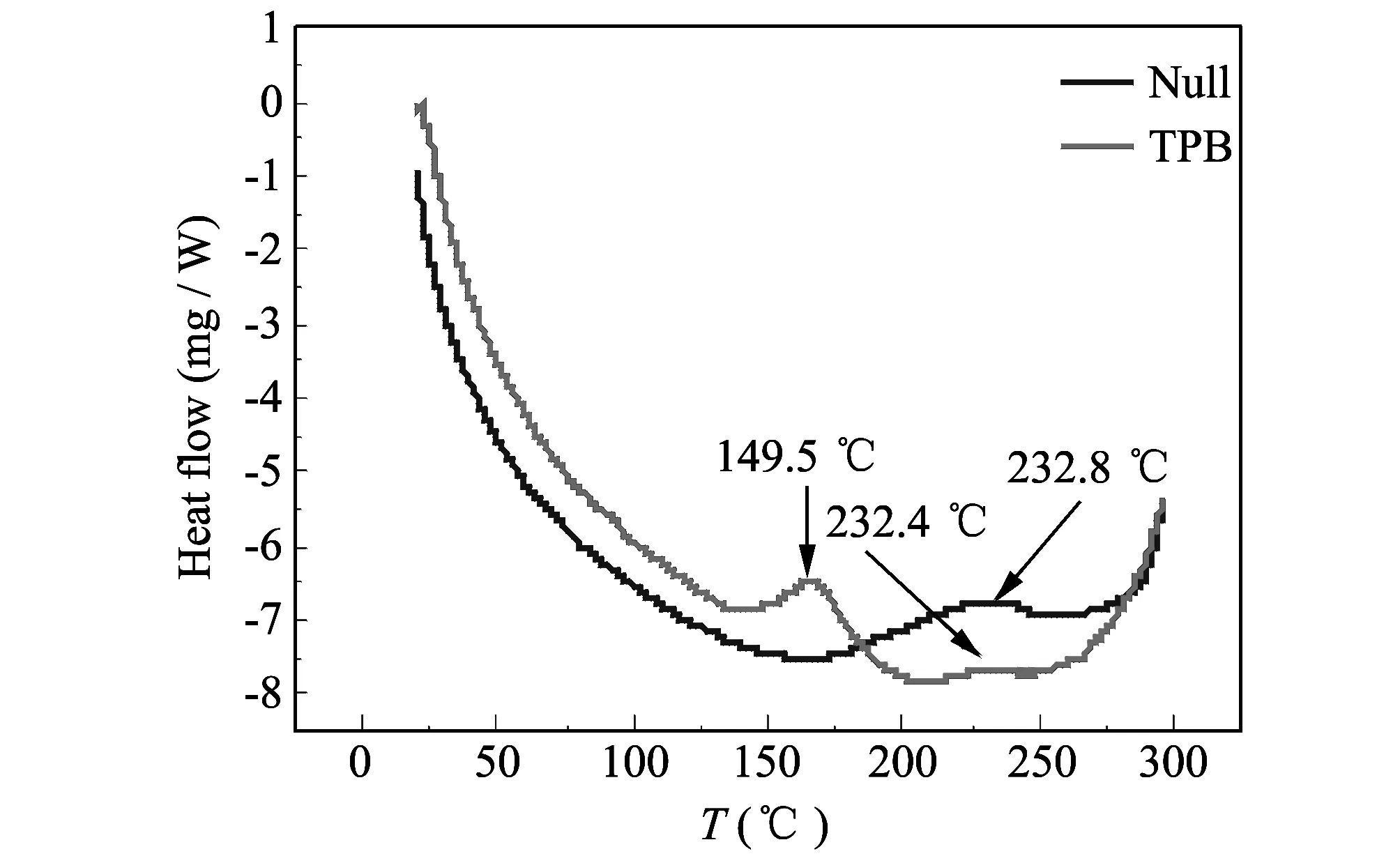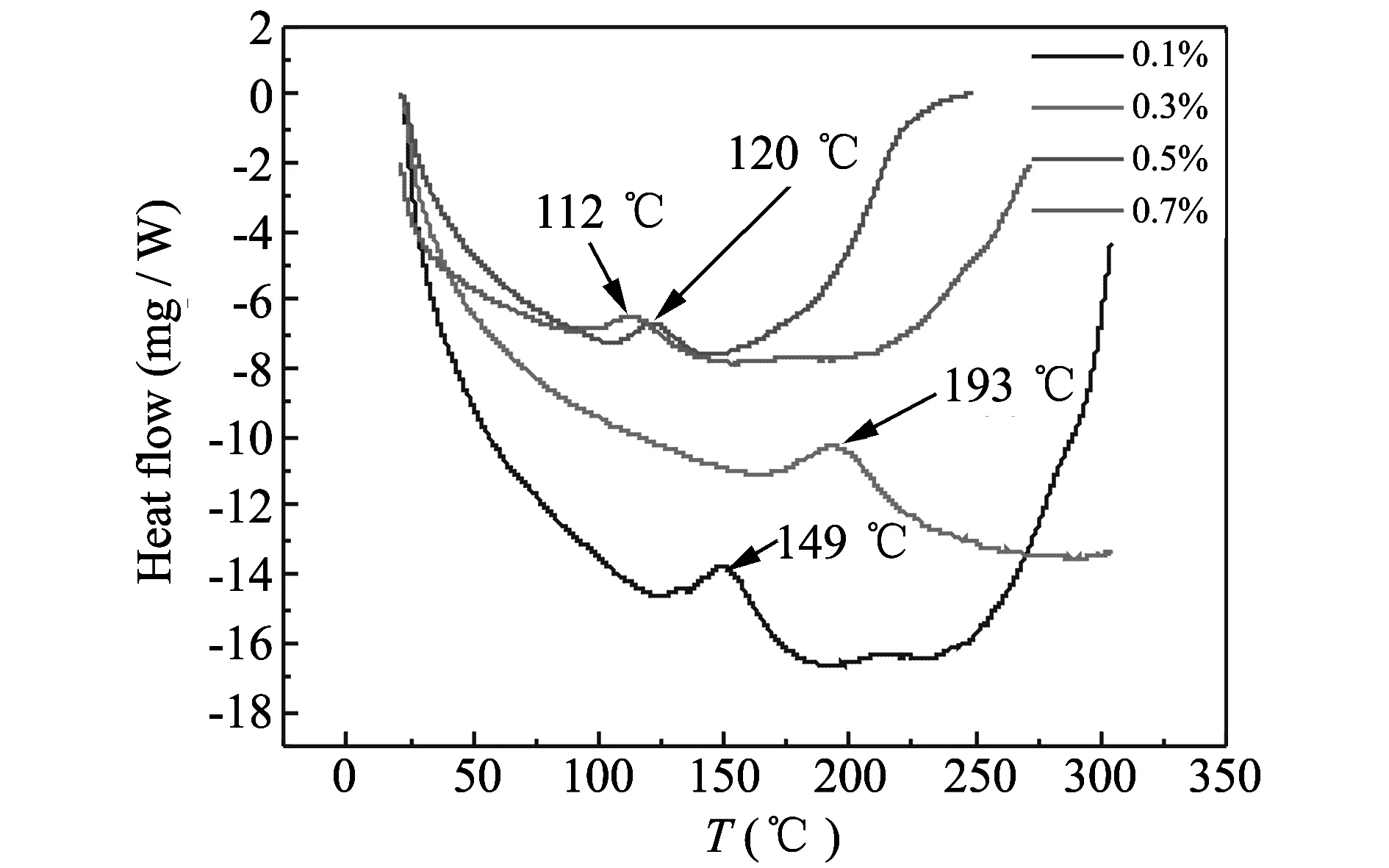Effect of TPB on curing reaction of HTPB-TDI
OU Ya-peng, CHANG Shuang-jun, ZHANG Bai-lei
(School of Chemical and Environmental Engineering, North University of China, Taiyuan 030051, China)
EffectofTPBoncuringreactionofHTPB-TDI
OU Ya-peng, CHANG Shuang-jun, ZHANG Bai-lei
(SchoolofChemicalandEnvironmentalEngineering,NorthUniversityofChina,Taiyuan030051,China)
Abstract:Catalysis effect of triphenyl bismuth (TPB) on kinetics of hydroxyl terminated polybutadiene-toluene diisocyanate (HTPB-TDI) curing reaction was studied by non-isothermal differential scanning calorimetry (DSC).The characteristic temperature of curing system was measured for calculating kinetic parameters and establishing curing reaction kinetic equations.The results show that activation energy (Ea) of uncatalyzed HTPB-TDI curing system is 51.29 kJ·mol-1, and TPB decreasesEato 46.43 kJ·mol-1.Catalyst lowers reaction temperature and shortens curing time through decreasing activation energy of curing reaction and accelerating reaction rate.TPB can increase the reaction rate at 27 ℃ to the value of uncatalyzed system at 80 ℃.The catalytic activity reaches the maximum when concentration is 0.5%.
Key words:hydroxyl-terminated polybutadiene (HTPB); catalyst; thermal analysis; curing reaction kinetics
CLDnumber: V512Documentcode: A
Hydroxyl terminated polybutadiene (HTPB) is extensively used as binder in composite solid propellants and cast polymer bonded explosive (PBX) due to its convenience for casting and manufacturing[1-3].The binder imparts dimensional stability and structural integrity to the grain for appropriate mechanical properties.The low reaction rate of the urethane forming cure reaction of HTPB binder with isocyante curative causes high curing temperature and long manufacturing period.The curing temperature of composite solid propellants and cast PBX using HTPB as binder is about 60 ℃ in actual production[4].High manufacturing temperature reduces the safety of propellants and cast PBX productive process and increases the production cost.The grain gets residual stress which reduces the mechanical properties of PBX and propellants after cooled to ambient temperature.Considering the above-mentioned reasons, catalysts are widely used for reducing the curing temperature and curing time[5].Dibutyltin dilaurate (DBTDL), ferric tris (acetyl acetonate)(Fe(AA)3) and triphenyl bismuth (TPB) are commonly used as catalysts.The catalytic activity and mechanism have been investigated using various techniques[6-9].But the reason for high catalytic activity, especially from the perspective of reaction kinetic, is still obscure.
This paper focuses on the reaction kinetics of TPB catalyzed hydroxyl terminated polybutadiene-toluene diisocyanate (HTPB-TDI) curing reaction, calculation of kinetic parameters and establishment of curing reaction kinetic equations.The catalysis effect of catalyst concentration on curing reaction is also presented.
1 Experiment
1.1 Materials
HTPB resin was manufactured at Luoyang Liming Institute of Chemical Technology of China.The important properties include hydroxyl value of 44.13 mg KOH/g and average molecular mass of 2 800 g/mol.TDI and TPB were obtained from commercial source and used as received.
1.2 Method
HTPB and TDI were mixed in equivalent ratio 1∶1.The curing reaction was studied at varied heating rates of 5,10,15 and 20 ℃/min for determining the kinetics by Kissinger and Crane methods.Catalyst concentration of 0.3% was reached by mass of the resin.The mixture of about 20 mg was taken in alumina pans and subjected to differential scanning calorimeter (DSC) analysis in a Setaram DSC131 in nitrogen atmosphere at a flow rate of 50 mL/min with heating temperature range of 20-300 ℃.Influence of catalyst concentration was investigated at four different catalyst concentrations of 0.1%, 0.3%, 0.5% and 0.7% (wt%).
2 Results and discussion
2.1 DSC test results
The DSC curves of uncatalyzed and TPB catalyzed HTPB-TDI curing systems at 15 ℃/min are depicted in Fig.1.It can be seen that the HTPB curing reaction is a single exothermic reaction, and catalyst decreases the reaction temperature and makes exothermic peak of DSC curve antedisplaced.

Fig.1 DSC curves of different curing systems at 15 ℃/min
The TPB catalyzed HTPB-TDI curing system has two apparent exothermic peaks.According to the research on catalytic mechanism,TPB was shown to be able to associate with hydroxyl.The most operative mechanism is through activating the isocyanate-hydroxyl complex, which increases as reactions proceed.The first exothermic peak, which the association of TPB with hydroxyl hydrogen increases the nucleophilicity of the adjacent oxygen in the hydroxyl.Therefore, the catalyzed reactions of hydroxyl with isocyanate may be suggested to involve the initial formation of a TPB-hydroxyl association and a subsequent reaction of the formed associate with isocyanate, in which the urethane is formed.After that, the catalyst is regenerated, which results in the second exothermic peak.
Tables 1 and 2 show the initial curing temperature(Ti), peak curing temperature(Tp) and final curing temperature(Tf) of DSC curves of uncatalyzed and TPB catalyzed HTPB-TDI curing systems.There are early and later stages in the DSC curve of TPB catalyzed HTPB-TDI curing system.But the later stage is not apparent at other heating rates, which indicates that TPB-isocyanate-hydroxyl association or complex is not quite stable and the TPB regenerating reaction nearly happens after the hydroxyl-isocynate reaction.Thus, only the early stage is discussed in this paper.The peak temperature of the early stage was reduced by 80 ℃ compared to uncatalyzed curing system.And the curing reaction peak temperature gradient(Tf-Ti) was decreased from 50-20 ℃.The above data show that TPB can decrease the curing reaction temperature and shorten reaction time.The high catalytic activity of TPB is cincident with the reaction mechanism.

Table 1 DSC data of HTPB-TDI curing reaction

Table 2 DSC data of TPB catalysed HTPB-TDI reaction
2.2 Kinetics of TPB catalyzed HTPB-TDI curing system
Kinetic parameters of curing reaction are calculated by Kissinger and Crane methods.
Kissinger formula:
(1)
Crane formula:
BecauseEa/nR≫2TP,
(2)
whereβis the heating rate,Eais the activation energy of curing reaction,Ris the universal gas constant,Tis the absolute temperature andnis the order of reaction.
The HTPB-TDI curing system abidesnorder reaction model according to the research on the curing reaction mechanism of HTPB[10-11],and reaction kinetic model equation is
(3)
whereαis the degree of reaction,tis the reaction time, dα/dtis the reaction rate andkis the reaction rate constant which follows the Arrhenius formulak=Aexp(-Ea/RT).Eq.(3) is for all values ofnexceptn=1.


Fig.2 Linear fitting of -lnβ and vs.1 000/TP for uncatalyzed curing system

Fig.3 Linear fitting of -lnβ and vs.1 000/TP for TPB catalyzed system
The kinetic parameters of uncatalyzed HTPB-TDI curing system areEa=51.29 kJ/mol,A=7.7×104s-1, andn=0.86.The values of TPB catalyzed HTPB-TDI curing system areEa=46.43 kJ/mol,A=2.4×105s-1,andn=0.87.The above parameters were substituted into Eq.(3).
The kinetic equation of HTPB-TDI curing system is calculated as
The kinetic equation of TPB catalyzed HTPB-TDI-TPB curing system is calculated by
TPB decreases the activation energy of the curing reaction.This is the reason why TPB lowers the reaction temperature.The reaction orders of two curing systems are similar and approximate 1, which shows that catalyst does not change the elementary reaction of HTPB-TDI and curing reaction abidesn-order reaction model correspondingly.
The kinetic equations show that it is linear relationship between reaction rate constants and reaction temperatures.Reaction rate constants determine the reaction rate at the specified temperatures.Some reaction rate constants of uncatalyzed and TPB catalyzed curing reactions at significant temperatures are shown in Table 3.The curing temperature of HTPB is about 60-80 ℃ in actual production, and the reaction rate constant at 60 ℃ is barely 6.93×10-4s-1without catalyst.It causes the long curing period and low production efficiency of HTPB based on grain.The reaction rate constant of the TPB catalyzed curing system at 27 ℃ is 1.98×10-3s-1, which reacheskvalue of the uncatalyzed system at 80 ℃.High temperature promotes isocyanate groups reacting with carbamic acid ester or urea linkages and generating cross bond.It decreases the properties of HTPB.High manufacture temperature reduces the safety of propellant and cast PBX productive process.It is the reason why catalysts are added to decrease tie manufacture temperature.TPB can make the curing reaction rate reach the value at high temperature without catalyst at low temperature.The above data prove that TPB is available for efficient catalyst based on reaction kinetics.

Table 3 Raue constants at different temperatures
2.3 Effect of TPB concentrations on catalytic activity
Fig.4 is the DSC curves of different TPB concentration catalyst systems at heating rate of 15 ℃/min, and concentrations of TPB are 0.1%,0.3%,0.5% and0.7%.The curing temperatures decrease with the increasing of concentration.Trend of temperature decreasing is slowing down after the concentration reaching a rather rich value.

Fig.4 DSC curves of different TPB concentrations catalyst system
Table 4 shows the peak temperatures of the DSC curves.It can be seen that it is linear relationship between temperature decreasing and the concentration increasing range from 0.1% to 0.5%.The curng temperature peak decreases by 15 ℃ with the concentration increasing by 0.1%.After the concentration reaching 0.5%, the peak value just decreases by 8 ℃ with the concentration increasing by 0.2%.It indicates that the catalytic activity reaches the maximum when concentration is 0.5%.
Table4DSCdataofdifferentTPBconcentrations'catalystsystem

TPBconcentration 0.1%0.3%0.5%0.7%TP/℃193149120112
3 Conclusion
BecauseEaof uncatalyzed HTPB-TDI curing system is 51.29 kJ/mol andEaof the TPB catalyzed system is 46.43 kJ/mol, catalyst decreases the activation energy of curing reaction and reaction temperature.HTPB-TDI-TPB system curing reaction kinetic equation is dα/dt=240 000(1-α)0.87×exp (-5 584/T), and the reaction rate constant at 27 ℃ reaches the value of the uncatalyzed system at 80 ℃.TPB is able to catalyze HTPB-TDI curing reaction at low temperature.The catalytic activity of TPB increases with the concentration and reaches the maximum when concentration is 0.5%.The appropriate concentration of TPB is 0.5%.
[1] WANG Jing-yu, AN Cong-wei, LI Gang, et al.Preparation and performances of castable HTPB/CL-20 booster explosives.Propellants Explos Pyrotech, 2011, 36(1): 34-41.
[2] Kumar A S, Rao V B, Sinha R K, et al.Evaluation of plastic bonded explosive (PBX) formulations based on RDX, aluminum, and HTPB for underwater applications.Propellants Explos Pyrotech, 2010, 35: 359-364.
[3] Kumar-Nanda J, Ramakrishna P A.Development of AP/HTPB based fuel-rich propellant for solid propellant ramjet.In: Proceedings of the 49th AIAA/ASME/SAE/ASEE Joint Propulsion Conferences, 2013: 4149-4171.
[4] Thibieroz B, Lecume S, Bigot Y.Development and characterization of PBX cast at ambient temperature.Insensitive In: Proceedings of Munitions and Energetic Materials Technology Symposium, 2001: 531-542.
[5] Korah-Bina C, Kannan K G, Ninan K N.DSC study on the effect of isocyanates and catalysts on the HTPB cure reaction.Journal of Thermal Analysis and Calorimetry, 2004, 78(3): 753-760.
[6] Volkova E R, Tereshatov V V, Karmanov V I.Influence of the concentration of iron(III) tris(acetylacetonate) used as urethane formation catalyst on the structure and properties of cold-cure polyurethanes.Russian Journal of Applied Chemistry, 2011, 84(8): 1414-1417.
[7] CHANG Shuang-jun, YANG Xue-qin, ZHAO Lu-kui.Catalysis effect on curing catalysis of HTPB-IPDI binder system.Modern Chemical Industry, 2011, 3: 215-218.
[8] ZHOU Zhi-hua, LIU Wei, CUI Guang-hui.Study on effects of bis(hydroxymethyl) ferrocene in HTPB binder systems.Chemical Propellants & Polymeric Materials, 2013, 11(4): 66-68.
[9] LU Guo-lin, XIA Qiang, DU Juan.Catalysis effect on TPB on the cure of HTPB-based high burning rate propellant.Chinese Journal of Energetic Materials, 1999, 7(2): 60-66.
[10] Singh M, Kanungo B K, Bansal T K.Kinetic studies on curing of hydroxy-terminated polybutadiene prepolymer-based polyurethane networks.Journal of Applied Polymer Science, 2002, 85(4): 842-846.
[11] CHEN Chun-yan, WANG Xiao-feng, GAO Li-long, et al.Effect of HTPB with different molecular weights on curing kinetics of HTPB/TDI system.Chinese Journal of Energetic Materials, 2013, 21(6): 771-776.
TPB对HTPB-TDI固化反应的影响
欧亚鹏, 常双君, 张百磊
(中北大学 化工与环境学院, 山西 太原 030051)
摘 要:采用非等温示差扫描量热法(DSC)研究了三苯基铋(TPB)对HTPB-TDI体系固化反应动力学的影响。 测定了其固化峰温, 以Kissinger法和Crane法计算其活化能等动力学参数, 列出了固化反应动力学方程。 结果表明, 未加催化剂时活化能为51.29 kJ/mol, 加入TPB后活化能降至46.43 kJ/mol。 因此, TPB能有效地降低固化反应的活化能, 加快反应速率, 降低反应温度, 缩短固化时间, 并使固化体系在27 ℃时的反应速率达到未加催化剂时80 ℃的值, 当催化剂浓度为0.5%时, 催化活性达到最大。
关键词:端羟基聚丁二烯(HTPB); 催化; 热分析; 固化反应动力学
引用格式:OU Ya-peng, CHANG Shuang-jun, ZHANG Bai-lei.Effect of TPB on curing reaction of HTPB-TDI.Journal of Measurement Science and Instrumentation, 2014, 5(4): 89-92.[doi: 10.3969/j.issn.1674-8042.2014.04.017]
Article ID:1674-8042(2014)04-0089-04
10.3969/j.issn.1674-8042.2014.04.017
Receiveddate: 2014-09-15
Foundation item:Natural Science Foundation of Shanxi Province
Corresponding author:OU Ya-peng (ouyapeng@126.com)
 Journal of Measurement Science and Instrumentation2014年4期
Journal of Measurement Science and Instrumentation2014年4期
- Journal of Measurement Science and Instrumentation的其它文章
- Nonlinear principal resonance of magneto-electro-elastic thin plate
- Measurement and control system for servo pressure pulse testing equipment
- Polarization state measurement based on photoelastic modulation
- Mosaic line-scan camera based on FPGA
- Detection technique of moving target based on passive millimeter wave
- Empirical model of correction for zenith tropospheric delay
